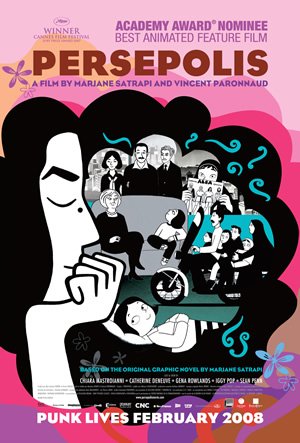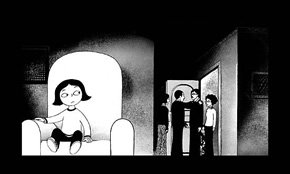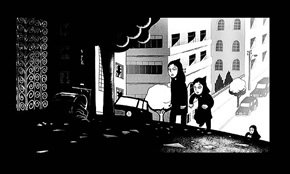<AWARDS & NOMINATIONS>
Academy Awards Nomination
Best Animated Feature Golden
Globe Nomination
Best Foreign Language Film
New
York Film Critics
BEST FOREIGN PICTURE (Tie with "The Lives of Others")
Los
Angeles Film Critics
BEST ANIMATION AWARD (Tie with "Ratatouille")
Cannes
Film Festival ~ Grand Jury Prize
Genre: Animation/Drama
Director: Marjane Satrapi, Vincent Paronnaud
Cast: Catherine Deneuve, Chiara Mastroianni
RunTime: 1 hr 35 mins
Released By: Festive Films & Cathay-Keris
Films
Rating: PG (SOME SEXUAL AND DRUG REFERENCES)
Official Website:
Opening Day: 21 February 2008
Synopsis:
"Persepolis" is the poignant story of a young girl
in Iran during the Islamic Revolution. It is through the eyes
of precocious and outspoken nine year old Marjane that we
see a people's hopes dashed as fundamentalists take power
- forcing the veil on women and imprisoning thousands. Clever
and fearless, she outsmarts the "social guardians"
and discovers punk, ABBA and Iron Maiden. Yet when her uncle
is senselessly executed and as bombs fall around Tehran in
the Iran/Iraq war, the daily fear that permeates life in Iran
is palpable.
As
she gets older, Marjane's boldness causes her parents to worry
over her continued safety. And so, at age fourteen, they make
the difficult decision to send her to school in Austria. Vulnerable
and alone in a strange land, she endures the typical ordeals
of a teenager. In addition, Marjane has to combat being equated
with the religious fundamentalism and extremism she fled her
country to escape. Over time, she gains acceptance, and even
experiences love, but after high school she finds herself
alone and horribly homesick.
Though
it means putting on the veil and living in a tyrannical society,
Marjane decides to return to Iran to be close to her family.
After a difficult period of adjustment, she enters art school
and marries, all the while continuing to speak out against
the hypocrisy she witnesses. At age 24, she realizes that
while she is deeply Iranian, she cannot live in Iran. She
then makes the heartbreaking decision to leave her homeland
for France, optimistic about her future, shaped indelibly
by her past.
Movie Review:
“Persepolis” is a persuasive reminder of struggles
still remnant in the Middle East with Iran taking centrestage
during these times of dangerous rhetoric. The blossoming political
consciousness of a young girl is dutifully evinced in Marjane
Satrapi's (co-directed by Vincent Paronnaud) feature animation
adapted from an autobiographical graphic novel by Satrapi,
an Iranian exile in France. She tells her story with an uncommon
grace, an elegant emotional journey fraught with the bittersweet
remembrance of youth and the aching longing for her heritage
left behind in Tehran, and her formative years with a loving
and progressive family.
Satrapi
invokes post 9/11 prejudices and the collision of cultural
norms with the colour-laden opening sequence set in an airport
where she waits for a flight as a grown woman in her traditional
headscarf and a cigarette in hand, cognisant of the suspicious
looks she receives from those around her. The film’s
framing device takes shape as a monochromatic flashback is
constructed into 1978 Iran, where eight-year-old Marjane Satrapi
is obliviously practicing her “Enter the Dragon”
routine, right smack in the middle of collective vigilance,
in a country on the verge of an inevitable clash between liberal
modern secularism and oppressive religious tyranny. A quick
history lesson tells of the deposed Shah’s suppressive
rule giving way to an even more fundamentalist regime under
the ayatollah. Regardless of the social turmoil unfolding
around the neighbourhoods, the playgrounds and her apartment,
Marjane lives her childhood, with the kinship of her fiercely
spirited family, as happy as she possible can.
This
is the film’s strongest segment in its bifurcated narrative,
which further bleeds into Marjane’s adolescence and
personal upheavals. The scenes with her as a child are a joy
to witness as we see how her burgeoning ideas are moulded
from an unbridled imagination and the intellectual stimulation
that her immediate environments now offers her as she starts
forming vital (but often times flawed) opinions and observations
of people around her, including those who she would never
again see. As her childhood wanes, Satrapi wistfully looks
back at her naiveté as a time of not mere transition,
but as a time of implicit obligation, as the burden of state-enforced
tradition forces a change of perception when her mother and
grandmother are subjugated against their will to adhere to
patriarchal conservatism by donning pitch-black veils that
mask not just their faces, but their identities in its most
personal sense.
The
film’s starkly vivid aesthetics are in contrast to the
rich emotions extrapolated from Satrapi’s narration.
The adherence to hand-drawn animation is congruent to one
of the film’s core themes of recalling the past while
marching forward to a future by pushing the antiquated technique
to innovative and expressionistic tableaus, and in the process
finds a sort of freedom in its austerity that offers its intimate
narrative fluidity as it traverses 30 years of personal and
political history with nary a blip.
As
Satrapi confronts her past, the monuments of history in Tehran
start to pale in comparison to individual epiphanies and personal
revolutions through different times and places. And one of
the grand truths of “Persepolis” is that growing
up, the quintessential coming-of-age story we all eventually
tell is by and large a trial by fire. It is a time when we
are unsure of who we are supposed to know, or what we are
supposed to be, and even wary of whether we want what we are
supposed to want.
“Persepolis”
eschews idealism for a tentative sense of identity in an increasingly
tumultuous world, the transposing of personal demons and the
roots that hark back to Satrapi despite various dislocations.
She configures the landscape of political upheaval to a distinctively
personal voice. It’s an unsentimental c’est la
vie, a stirring dictum of finding a foothold wherever we land
and never letting go what freedoms we come into the world
with.
Movie
Rating:
   
(Configures the landscape of political upheaval to a distinctively
personal voice)
Review by Justin Deimen
|



